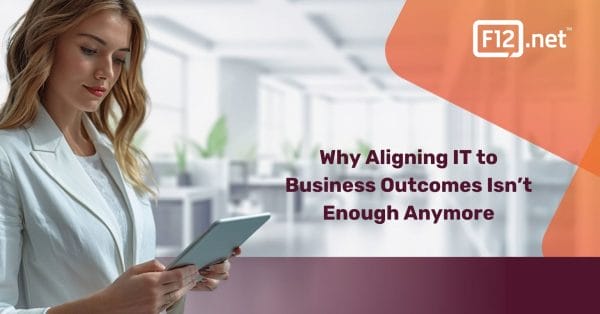The “Fourth Revolution” is upon us, and a business that doesn’t adapt may risk getting left behind. What technologies should you add to your company’s toolkit to help you innovate to improve your business?
In early 2022, F12’s CMO Devon Gillard was at an industry event when he met a team member from Koridor, a software development company that builds tech-led solutions to digitize and modernize companies, particularly SMEs. Devon was so inspired that he knew he had to sit down with Sepehr Shoarinejad, Koridor’s founder and president, to talk shop. In our latest webcast, Devon and Sepehr discussed the various ways an organization can innovate and grow, and why traditional development methods are too slow for today’s fast-paced digital economy.
What is the “Fourth Industrial Revolution”?
Sepehr: About 40% of companies today are still working on paper; they’re still on that traditional model.
Devon: Yeah, just because you printed that from a computer doesn’t mean you’ve revolutionized it…
Sepehr: Exactly! That’s not even close. The Fourth Revolution is where we went from the Industrial Age to the Age of the Internet. Now we’re in this world where there is an incredible number of tools available, and it’s amazing.
Use software services as a means to innovate and grow your business
Sepehr: I’ve been building products—software, specifically—and consulting with businesses for years now. I’d created and sold two businesses before launching Koridor, and so I always looked at business with the question of: how do you make money? How do you make your business productive and efficient, where it can be less reliant on people and more reliant on technology? That’s how I always looked at it: people cost money and managing them is not easy. Whereas, with tech, you pay for it and you start working with it.
Work with a consultant that knows their stuff and can help you innovate
Sepehr: I started working with start-ups because I had a passion for them. I liked talking to them, I liked trying to help them out. They’re thrown into this environment where the idea is: first survive, and then someone will invest in you. And they’re wondering, “How do I survive?” So it became a fun environment for me to guide them, because as a business owner who is also well versed in technology, I’m a weird, hybrid bridge, and I’m able to see both sides.
Devon: All businesses, even if you’re a non-profit, have competition. You’re trying to maximize return on the investment to realize your vision, and businesses are exploring different ways of doing that. It often can feel like innovative application development is really only for the Googles and Amazons of the world, but a SME can actually develop a differentiated technology solution from the ground up.
Explore the plethora of innovative options with modern SaaS models
Sepehr: Using the traditional development model is very pricey. We’re talking minimal to no digitization, everything is still done on paper. But it’s expensive and outdated, so why would you use it? In today’s world, there are so many products out there with the SaaS (software as a service) model. And I don’t mean out-of-the-box; there are products that you can fully customize. Low-code, no-code applications that you can actually utilize to really project your company into that realm of custom application without having to spend hundreds of thousands of dollars. To put a value on [the Saas models], you can do things for as low as $10,000, all the way up to $100,000 if you want to, but there are a lot of tools that businesses can use today to really get their business up to speed.
Consider the limitations of using an out-of-the-box product
Devon: When it comes to adopting out-of-the-box software, it can be great because it’s generally inexpensive, but I’d argue that to effectively use the software, you have to use its canned processes. And guess what? You’re using the same software that’s used by 90% of competitors in your industry. Your business processes are going to be the same as your competitors. Not to mention, how well can you use a process for your business that was invented by somebody else?
Sepehr: And that’s exactly what an out-of-the-box is: it is designed for the general public, so it’s impossible for them to create a product where it’s customized to every single person or business. If you’re a smaller company that doesn’t necessarily have a process already created and is adaptable, sure, you can use it. But a bigger company (Koridor’s rule of thumb is minimum 30 employees) will have complex systems, workflows, different items to run. And so that out-of-the-box product suddenly becomes detrimental to your business.
Grow your systems through agile development versus waterfall development
Sepehr: When using Salesforce or SAP (Systems Applications and Products in data processing), you have to build your entire model right off the bat. It’s the waterfall development process. You have to figure everything out right at the beginning. Whereas most businesses today, in my opinion, need an agile development process. You need to be able to adapt and consistently change and make adjustments to the product, to come out and say, okay, this is inefficient, let’s make this more productive. Those tools allow you to be agile.
Identify risks to your company by refusing to adapt or embrace innovation
Sepehr: In terms of what percentage of companies have really adapted technology, the 40%, those guys have really struggled. If they don’t adapt in the next, I would say, five to 10 years, and become more technologically involved, then in my opinion they’re going to be up against stiff competition. If they have 20 employees and are working away, but their competitor comes out with only 10 employees, the competitor is going to be more cashflow efficient. They’re going to be faster than the 20-employee company. And that’s going to be a game changer for a lot of start-ups.
Devon: At F12 we know the value of being adaptable. To be a great IT partner, we need to have systems that can adapt to our client’s vocabulary and processes, while also making sure our staff don’t lose their minds. This is the future, and it’s what you need to figure out to keep up.
Deploy personalization as an innovative strategy
Sepehr: I think personalization is the key to winning customers. Discovering how you’re going to be able to do that in your business—that’s a whole different scope. But the only thing that’s going to allow you to do that is technology, hands down. Computers are great at doing tasks. Humans suck at doing tasks, but they’re very good at problem solving. We are designed to solve problems. And that’s something that computers can barely do today.
Remember: having a business idea is the easy part
Sepehr: I’m not degrading anybody’s idea, but the idea is the easy part. The execution is the hardest part. If you have an idea, try to find a good partner. Don’t be scared by the idea because you think it’s going out be expensive. Trust me: in today’s world, you don’t know what tools are out there. It’s better to just ask, consult, and talk to somebody; try to get an understanding around it.
If you’re a small- to medium-enterprise ready to be innovative and grow your business with new technology (no more “traditional model” for you!), then let us help you figure out the best tools for your company.


